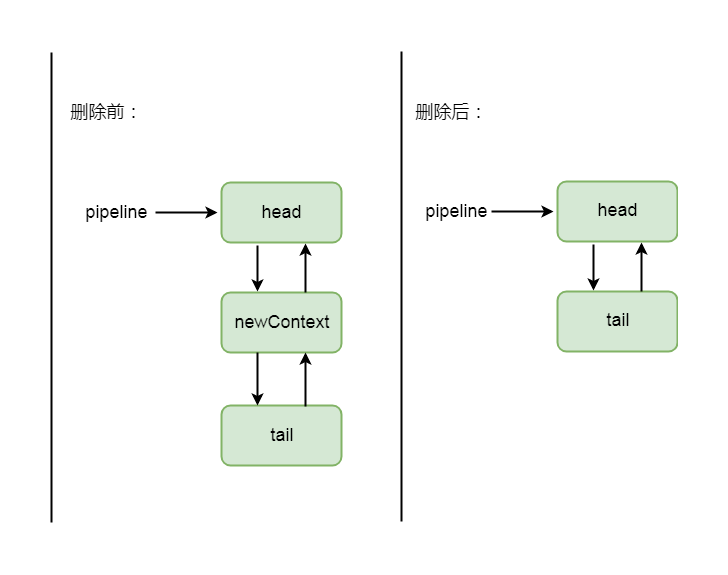Netty原始碼分析第4章(pipeline)---->第3節: handler的刪除
Netty原始碼分析第四章: pipeline
第三節: handler的刪除
上一小節我們學習了新增handler的邏輯操作, 這一小節我們學習刪除handler的相關邏輯
如果使用者在業務邏輯中進行ctx.pipeline().remove(this)這樣的寫法, 或者ch.pipeline().remove(new SimpleHandler())這樣的寫法, 則就是對handler進行刪除, 我們學習過新增handler的邏輯, 所以對handler刪除操作理解起來也會比較容易
我們首先跟到defaultChannelPipeline的remove(handler)的方法中:
public final ChannelPipeline remove(ChannelHandler handler) {
remove(getContextOrDie(handler));
return this;
}
方法體裡有個remove()方法, 傳入一個 getContextOrDie(handler) 引數, 這個 getContextOrDie(handler) , 其實就是根據handler拿到其包裝類HandlerContext物件
我們跟到getContextPrDie這個方法中:
private
這裡仍然會通過context(handler)方法去尋找, 再跟進去:
public final ChannelHandlerContext context(ChannelHandler handler) {
if (handler == null
這裡我們看到尋找的方法也非常的簡單, 就是從頭結點開始遍歷, 遍歷到如果其包裝的handler物件是傳入的handler物件, 則返回找到的handlerContext
回到remove(handler)方法:
public final ChannelPipeline remove(ChannelHandler handler) {
remove(getContextOrDie(handler));
return this;
}
繼續跟到remove方法中:
private AbstractChannelHandlerContext remove(final AbstractChannelHandlerContext ctx) {
//當前刪除的節點不能是head, 也不能是tail
assert ctx != head && ctx != tail;
synchronized (this) {
//執行刪除操作
remove0(ctx);
if (!registered) {
callHandlerCallbackLater(ctx, false);
return ctx;
}
//回撥刪除handler事件
EventExecutor executor = ctx.executor();
if (!executor.inEventLoop()) {
executor.execute(new Runnable() {
@Override
public void run() {
callHandlerRemoved0(ctx);
}
});
return ctx;
}
}
callHandlerRemoved0(ctx);
return ctx;
}
首先要斷言刪除的節點不能是tail和head
然後通過remove0(ctx)進行實際的刪除操作, 跟到remove0(ctx)中:
private static void remove0(AbstractChannelHandlerContext ctx) {
//當前節點的前置節點
AbstractChannelHandlerContext prev = ctx.prev;
//當前節點的後置節點
AbstractChannelHandlerContext next = ctx.next;
//前置節點的下一個節點設定為後置節點
prev.next = next;
//後置節點的上一個節點設定為前置節點
next.prev = prev;
}
這裡的操作也非常簡單, 做了一個指標移動的操作, 熟悉雙向連結串列的小夥伴應該不會陌生, 刪除節點邏輯大概如下圖所示:

4-3-1
回到remove(ctx)方法:
private AbstractChannelHandlerContext remove(final AbstractChannelHandlerContext ctx) {
//當前刪除的節點不能是head, 也不能是tail
assert ctx != head && ctx != tail;
synchronized (this) {
//執行刪除操作
remove0(ctx);
if (!registered) {
callHandlerCallbackLater(ctx, false);
return ctx;
}
//回撥刪除handler事件
EventExecutor executor = ctx.executor();
if (!executor.inEventLoop()) {
executor.execute(new Runnable() {
@Override
public void run() {
callHandlerRemoved0(ctx);
}
});
return ctx;
}
}
callHandlerRemoved0(ctx);
return ctx;
}
我們繼續往下看, 如果當前執行緒不是eventLoop執行緒則將回調刪除事件封裝成task放在taskQueue中讓eventLoop執行緒進行執行, 否則, 則直接執行回撥刪除事件
跟到callHandlerRemoved0(ctx)方法中:
private void callHandlerRemoved0(final AbstractChannelHandlerContext ctx) {
try {
try {
//呼叫handler的handlerRemoved方法
ctx.handler().handlerRemoved(ctx);
} finally {
//將當前節點狀態設定為已移除
ctx.setRemoved();
}
} catch (Throwable t) {
fireExceptionCaught(new ChannelPipelineException(
ctx.handler().getClass().getName() + ".handlerRemoved() has thrown an exception.", t));
}
}
與新增handler的邏輯一樣, 這裡會呼叫當前handler的handlerRemoved方法, 如果使用者沒有重寫該方法, 則會呼叫其父類的方法, 方法體在ChannelHandlerAdapter類中有定義, 我們跟進去
public void handlerRemoved(ChannelHandlerContext ctx) throws Exception {
}
同新增handler一樣, 也是一個空實現, 這裡使用者可以通過重寫來新增自己需要的邏輯
以上就是刪除handler的相關操作
